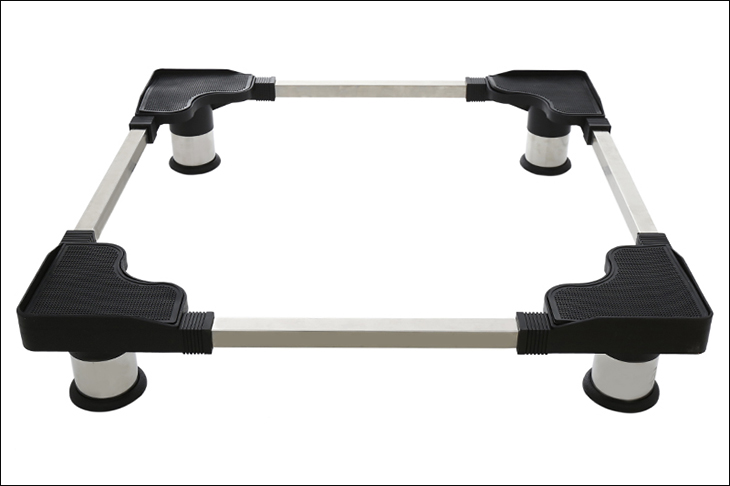Selecting the Right Detergent for Your Washing Machine
When it comes to choosing between washing powder and detergent, it is advisable to opt for the latter. Although detergent produces less foam, it effectively cleans clothes and prevents any residue that could potentially harm your device. Therefore, it is recommended to use detergent for an optimal and residue-free washing experience.
It is important to choose a reputable store when purchasing detergent, ensuring that you are buying genuine and high-quality products. A good detergent should be both effective in cleaning and safe for the skin. When adding detergent to your washing machine, it is crucial to use the appropriate amount for your clothes. Using too little may result in inadequate cleaning, while using too much can damage the machine and make it difficult to clean. Follow these guidelines for optimal laundry results and machine longevity.

Ensure Proper Clothing Load for Washing Machine Usage
Before loading clothes into the washing machine, it is advisable to first inspect the pockets and remove any items. Additionally, it is important to fully zip up garments, untangle any twisted socks, and straighten sweaters before placing them in the machine.
These recommended practices will safeguard the washing tub, mitigate collisions, and enhance the lifespan of the device. It is important to ensure that the amount of clothes being loaded aligns with the machine’s washing capacity. Overloading or underloading the machine can diminish its efficiency and result in increased energy consumption.

How to Choose the Best Washing Mode for Different Fabric Materials
Choose the appropriate mode based on fabric material
- Cotton: Use the “Delicate” mode as cotton is a delicate fabric that can easily shrink or wrinkle if exposed to high heat or rough agitation.
- Wool: Use the “Wool” mode which offers gentle heat and minimal agitation to prevent damage to delicate wool fibers.
- Silk: Use the “Silk” mode which is specifically designed for delicate silk fabrics to minimize heat and agitation.
- Polyester: Use the “Normal” mode as polyester is a durable fabric that can withstand regular heat and agitation.
- Linen: Use the “Cotton” mode as linen is a similar fabric to cotton and can also be treated as delicate.
- Denim: Use the “Heavy-Duty” mode as denim is a sturdy fabric that can handle higher heat and rough agitation.
- Rayon: Use the “Delicate” mode as rayon is a delicate fabric that can easily shrink or wrinkle if exposed to high heat or rough agitation.
- Nylon: Use the “Normal” mode as nylon is a durable fabric that can withstand regular heat and agitation.
-
Gentle mode: Our washing machine is equipped with a gentle mode specifically designed to handle delicate fabrics such as fine fabric, thin fabric, silk, satin, and shirts. This mode ensures that your delicate items are treated with the utmost care during the washing process so they retain their quality and avoid any damage.
-
Normal mode
Our clothing selection offers a variety of designs and materials suitable for everyday wear. From comfortable cotton to stretchy elastic, we have clothing options that prioritize comfort and versatility.
Our extensive collection of durable fabrics includes jean fabric, khaki, and many more. Explore our selection of strong fabrics that are perfect for all your projects. -
Clothes with excessive staining.
Selecting the correct washing mode not only safeguards your garments from harm, but also optimizes the machine’s performance, preventing unnecessary energy consumption.

How to Set the Right Water Temperature for Your Washing Machine
When selecting the water temperature for your laundry, it is important to consider the type of fabric and the preferences of the user. By adjusting the water temperature accordingly, you can ensure optimal cleaning and care for your clothes.
-
Around 30 – 40 degrees Celsius: It is recommended to wear lightweight clothing made of thin fabrics, such as cotton or linen. These fabrics are comfortable and breathable, but they may be more prone to tearing and fading over time.
-
At 40 degrees Celsius: This temperature is suitable for washing most fabric materials, with the exception of sportswear, dark-colored clothes, silk, and silk and wool garments.
-
Around 40 – 60 degrees Celsius: These temperatures are suitable for direct-contact clothes with sensitive skin, such as underwear and baby diapers.
-
At 60 degrees Celsius: This temperature setting is suitable for color-fast fabrics such as cotton, mixed fabric, linen fabric, white cotton fabric, and more.
-
Temperature Range for Clothing
Between 60 – 95 degrees Celsius:
- Clothes for infants and toddlers
- Shirts
- Sleepwear
- White cotton fabric
Selecting the optimal water temperature not only promotes energy efficiency by reducing monthly electricity consumption, but also ensures enhanced safety for the skin, particularly in households with young children.

Adjusting Water Proportions: How to Get It Just Right
To ensure optimal performance, it is recommended to make adjustments to the water level in older washing machines that have fewer washing cycles. Prior to starting a wash cycle, it is important to maintain a proper ratio between the weight of the water and the amount of clothes being washed. A suitable ratio to observe is 20 parts water to 1 part clothes.
Ensuring optimal water levels is essential for conserving water and preserving the longevity of the machine. Overloading the product with excess water can lead to decreased performance and ultimately shorten its lifespan.

Advice: Hang Clothes Immediately After Washing, Don’t Delay Until Overnight
It is not advisable to leave damp clothes in a washing machine overnight, as this can lead to bacterial growth. Some individuals may have the habit of washing clothes in the evening and hanging them up the next morning, but this practice should be avoided. Dampness and a closed environment can create an ideal breeding ground for bacteria. To maintain hygiene and prevent bacterial multiplication, it is recommended to remove clothes from the washing machine immediately after the cycle is complete.
Once the washing program has finished, it is advisable to promptly remove the clothes from the machine and hang them up. Additionally, remember to open the door of the machine to ensure proper ventilation and allow the inside of the tub to thoroughly dry.

Tips on How to Regularly Clean and Maintain a Washing Machine
Regular maintenance is essential to keep your washing machine in optimal condition. It is recommended to clean the machine regularly to prevent dust accumulation and ensure a clean washing process. Wiping the exterior and detergent compartments with a cloth is advised as part of routine maintenance. Additionally, it is recommended to thoroughly clean the entire washing machine every 2 to 3 weeks. This will help maintain its efficiency and prolong its lifespan.
Proper maintenance and regular cleaning of your washing machine are essential, particularly when it comes to the washing tub. Since it directly comes into contact with clothes, it is crucial to ensure thorough cleanliness. By incorporating this routine into your washing machine care, you not only promote stable operation and extend its lifespan but also enhance the cleanliness of your laundry while preventing the growth of harmful bacteria. Moreover, this practice ensures the safety of users.

How to Properly Place a Washing Machine in Your Home
It is important to avoid moving the washing machine while it is in operation in order to ensure optimal performance. Ideally, the machine should be placed on a level surface to promote efficient, stable, and safe operation.
To ensure optimum safety, it is highly recommended to use protective measures such as equipment insulation. This not only aids in reducing noise and preventing vibration but also helps in preventing direct contact between the machine and water. By doing so, it prevents rust formation and prolongs the lifespan of the machine.

In addition, if you need to clean the exterior of your washing machine, you can conveniently do so with the help of a washing machine stand. This will help you save both time and effort, as you won’t have to move the machine around while cleaning.

Thank you for reading this article on effective usage of washing machines. If you have any inquiries or need further assistance, please feel free to leave a comment below.






































